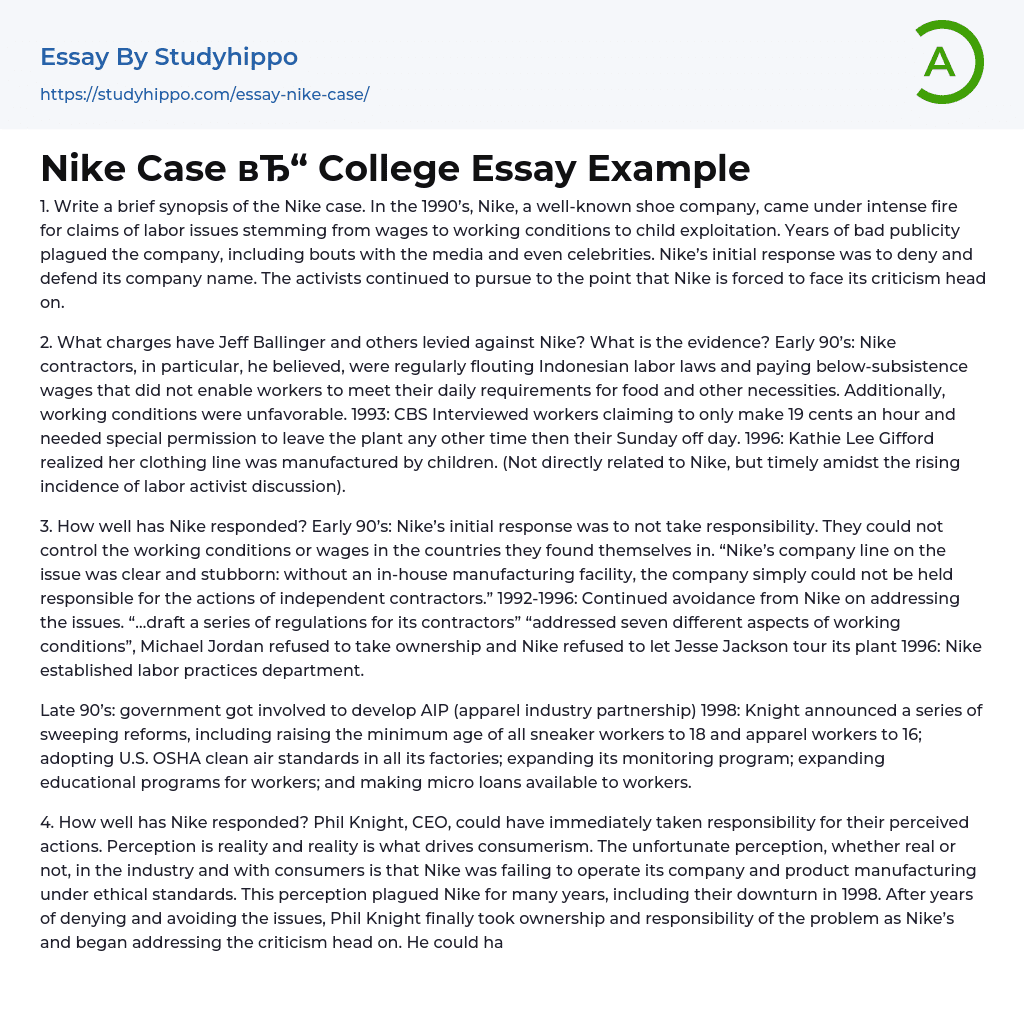1. Write a brief synopsis of the Nike case. In the 1990’s, Nike, a well-known shoe company, came under intense fire for claims of labor issues stemming from wages to working conditions to child exploitation. Years of bad publicity plagued the company, including bouts with the media and even celebrities. Nike’s initial response was to deny and defend its company name. The activists continued to pursue to the point that Nike is forced to face its criticism head on.
2. What charges have Jeff Ballinger and others levied against Nike? What is the evidence? Early 90’s: Nike contractors, in particular, he believed, were regularly flouting Indonesian labor laws and paying below-subsistence wages that did not enable workers to meet their daily requirements for food and other necessities. Additionally, working conditions were unfavorable. 1993: CBS Interviewe
...d workers claiming to only make 19 cents an hour and needed special permission to leave the plant any other time then their Sunday off day. 1996: Kathie Lee Gifford realized her clothing line was manufactured by children. (Not directly related to Nike, but timely amidst the rising incidence of labor activist discussion).
3. How well has Nike responded? Early 90’s: Nike’s initial response was to not take responsibility. They could not control the working conditions or wages in the countries they found themselves in. “Nike’s company line on the issue was clear and stubborn: without an in-house manufacturing facility, the company simply could not be held responsible for the actions of independent contractors.” 1992-1996: Continued avoidance from Nike on addressing the issues. “…draft a series of regulations for its contractors” “addressed seven different aspects of workin
conditions”, Michael Jordan refused to take ownership and Nike refused to let Jesse Jackson tour its plant 1996: Nike established labor practices department.
Late 90’s: government got involved to develop AIP (apparel industry partnership) 1998: Knight announced a series of sweeping reforms, including raising the minimum age of all sneaker workers to 18 and apparel workers to 16; adopting U.S. OSHA clean air standards in all its factories; expanding its monitoring program; expanding educational programs for workers; and making micro loans available to workers.
4. How well has Nike responded? Phil Knight, CEO, could have immediately taken responsibility for their perceived actions. Perception is reality and reality is what drives consumerism. The unfortunate perception, whether real or not, in the industry and with consumers is that Nike was failing to operate its company and product manufacturing under ethical standards. This perception plagued Nike for many years, including their downturn in 1998. After years of denying and avoiding the issues, Phil Knight finally took ownership and responsibility of the problem as Nike’s and began addressing the criticism head on. He could have done that from the get go and avoided some of the years of negative press.
5. What do you recommend to Nike going forward? Continue to cooperate with government and activist. Become more transparent in their operations overseas. Be open to criticism and listen to the statement prior to reacting.
- Administration essays
- Architect essays
- Discipline essays
- Doctor essays
- Engineer essays
- Farmer essays
- Hunter essays
- Labor essays
- Model essays
- Nurse essays
- Pilot essays
- Police Officer essays
- Professionalism essays
- Social Work essays
- Stakeholders essays
- Teamwork essays
- Adidas essays
- Amazon essays
- Apple essays
- Bmw essays
- British Airways essays
- Burger King essays
- Coca-Cola essays
- Company essays
- Costco essays
- Dell essays
- Ebay essays
- Enron essays
- Facebook essays
- Ford Motor Company essays
- Gap essays
- General Motors essays
- Google essays
- Honda essays
- Ibm essays
- Ikea essays
- Intel essays
- Iphone essays
- Johnson and Johnson essays
- Kellogg essays
- Key essays
- Kfc essays
- Mcdonald's essays
- Microsoft essays
- Myspace essays
- Nestle essays
- Netflix essays
- Nike essays
- Nokia essays
- Pepsi essays




